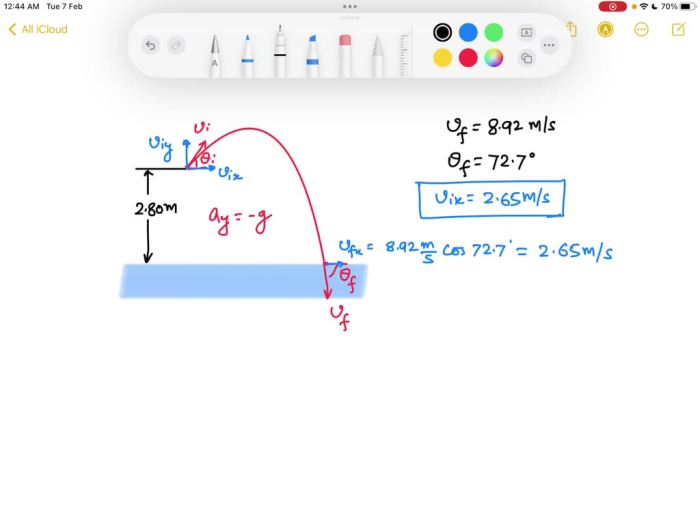A diver springs upward with an initial speed of – A diver springs upward with an initial speed, embarking on a captivating journey that showcases the interplay of physics and human movement. This action sets in motion a series of events, governed by the laws of motion and energy conservation, that determine the diver’s trajectory, height, and eventual return to the water’s surface.
The diver’s initial velocity, the forces acting upon them, and the energy transformations that occur during their ascent all contribute to the dynamics of this motion. Understanding these principles provides insights into the physics of diving and has practical applications in various fields, from sports to engineering.
1. Initial Velocity
When a diver springs upward, they are given an initial velocity, which is the velocity at which they leave the ground. This initial velocity affects both the diver’s trajectory and the height they reach.
The initial velocity of a diver can be calculated using the following formula:
v = u + at
where:
- v is the final velocity
- u is the initial velocity
- a is the acceleration due to gravity (9.8 m/s^2)
- t is the time
2. Forces Acting on the Diver

When a diver springs upward, they are acted upon by several forces, including gravity, buoyancy, and drag.
- Gravityis the force that pulls the diver back down to the ground.
- Buoyancyis the upward force exerted by the water on the diver.
- Dragis the force that opposes the diver’s motion through the water.
The relative strengths and directions of these forces determine the diver’s motion and trajectory.
3. Energy Considerations
When a diver springs upward, there is a conversion of energy from potential energy to kinetic energy. As the diver rises, their potential energy decreases and their kinetic energy increases. At the highest point of the dive, the diver’s potential energy is zero and their kinetic energy is at its maximum.
The conservation of energy can be used to determine the diver’s maximum height. The total energy of the diver at the beginning of the dive is equal to the total energy at the highest point of the dive:
E = PE + KE
where:
- E is the total energy
- PE is the potential energy
- KE is the kinetic energy
4. Trajectory and Height: A Diver Springs Upward With An Initial Speed Of

The diver’s trajectory during the upward spring is a parabola. The shape and angle of ascent are determined by the initial velocity, forces, and energy considerations.
The diver’s maximum height can be calculated using the following formula:
h = (v^2) / (2g)
where:
- h is the maximum height
- v is the initial velocity
- g is the acceleration due to gravity (9.8 m/s^2)
5. Real-World Applications

The physics of a diver springing upward has many practical applications in sports, engineering, and other fields.
- In sports, understanding the physics of diving can help athletes improve their performance. For example, divers can use this knowledge to optimize their initial velocity and trajectory to achieve greater heights and better scores.
- In engineering, the principles of diving can be used to design underwater structures and vehicles. For example, engineers can use this knowledge to design submarines that can withstand the forces of water pressure and to develop underwater robots that can explore the depths of the ocean.
Helpful Answers
What factors influence the height a diver reaches?
The diver’s initial velocity, the forces acting upon them (gravity, buoyancy, and drag), and the energy transformations that occur during their ascent all contribute to the height they reach.
How does the diver’s initial velocity affect their trajectory?
The diver’s initial velocity determines the angle of their ascent and the maximum height they will reach. A higher initial velocity results in a steeper angle of ascent and a greater height.
What is the role of energy conservation in a diver’s upward spring?
Energy conservation dictates that the total energy of the diver-Earth system remains constant throughout their ascent and descent. As the diver rises, their kinetic energy is converted into potential energy, and vice versa as they descend.
